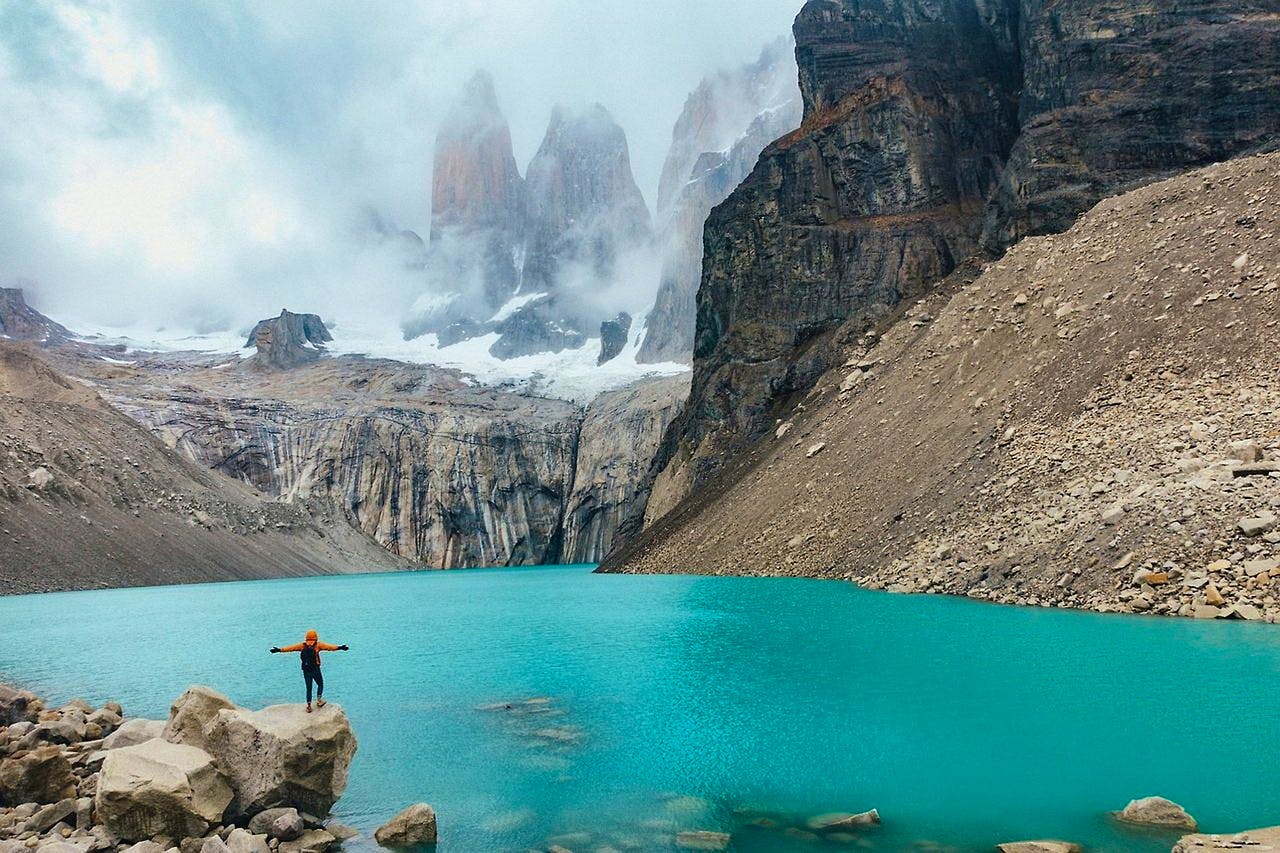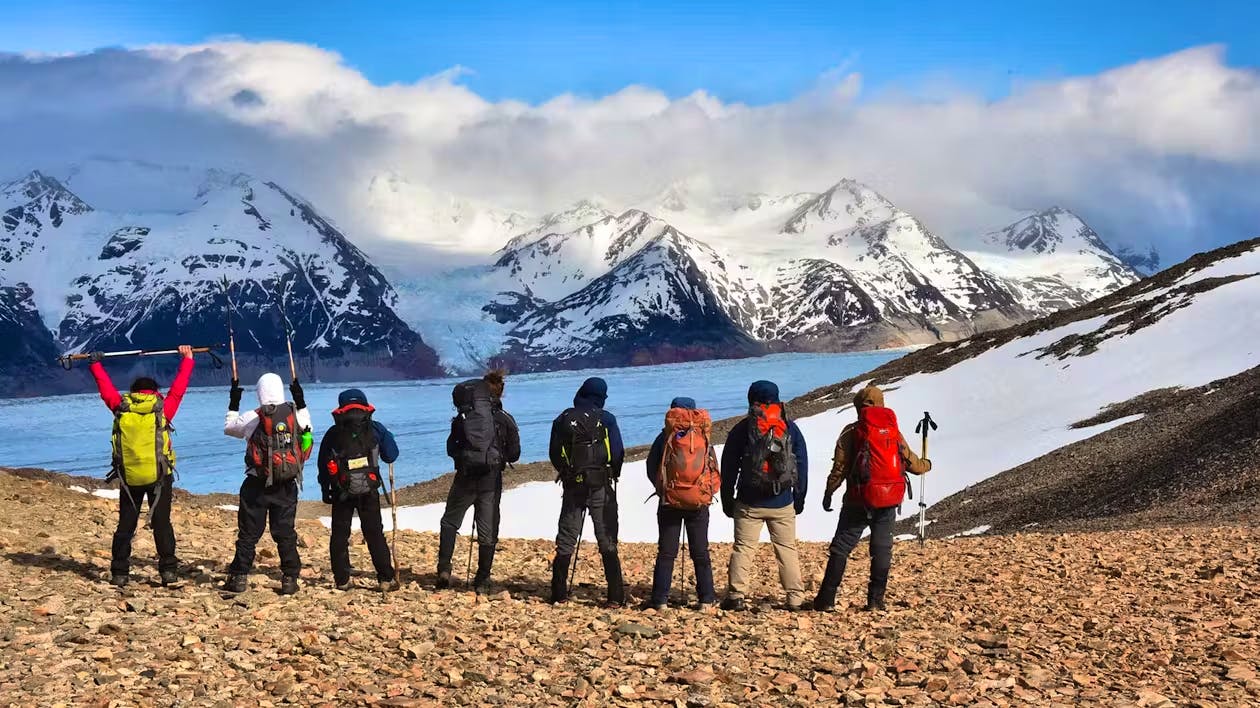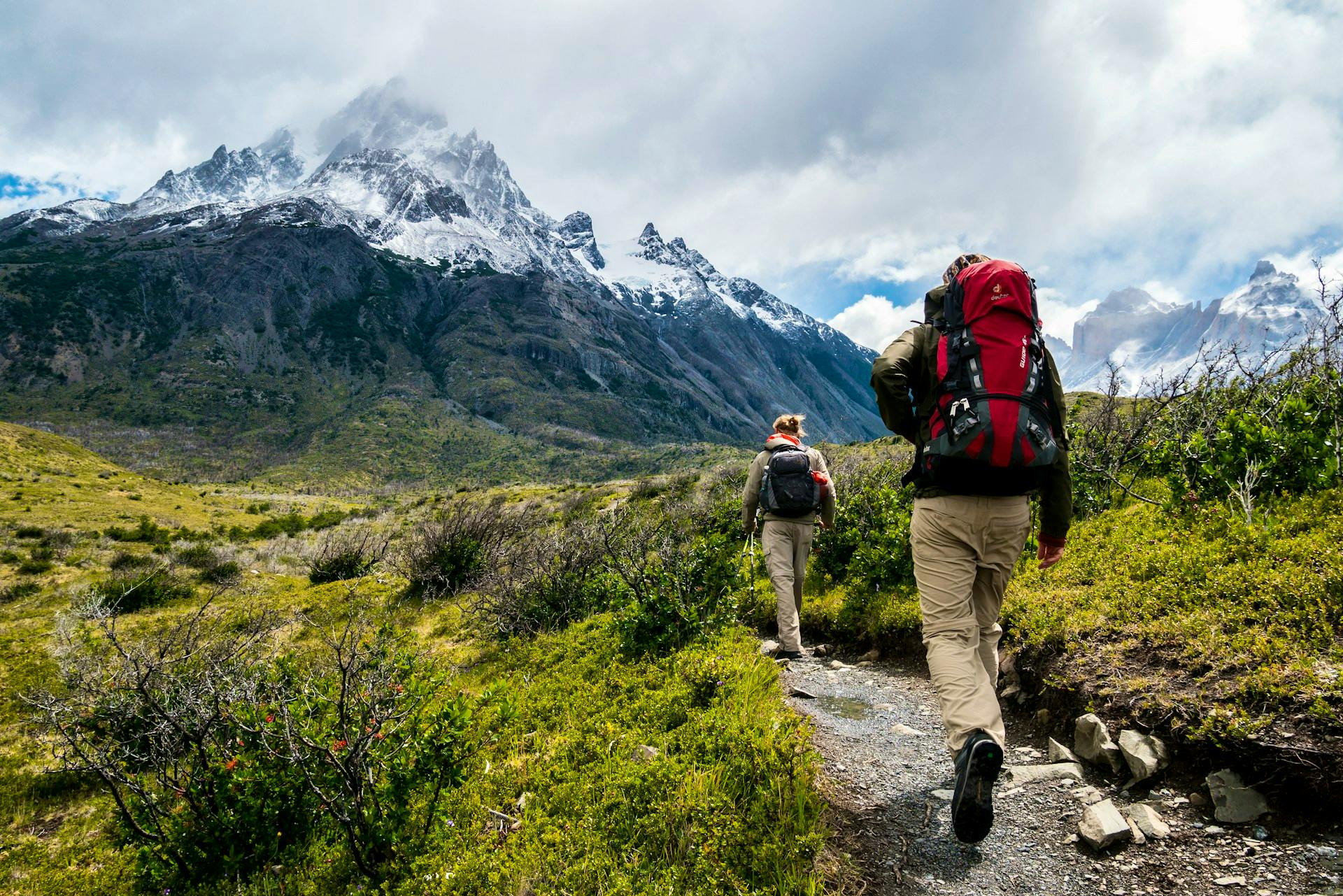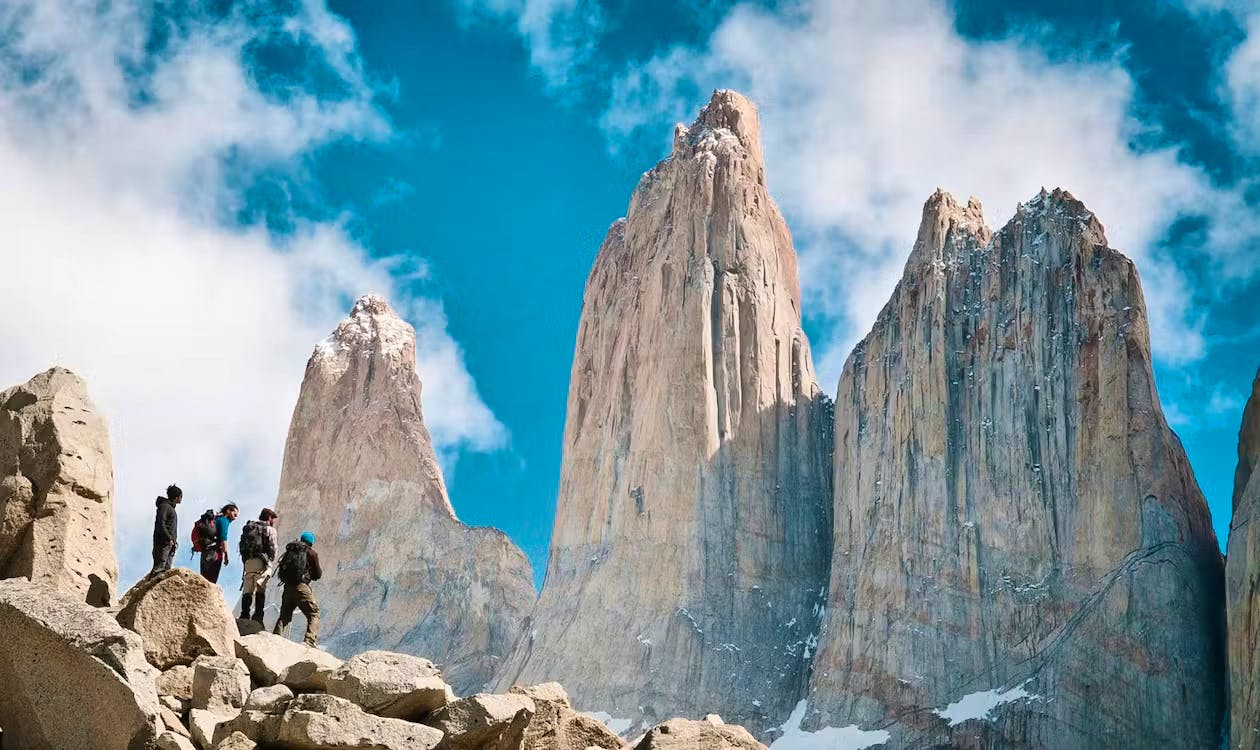Ready to lace up your boots for the Patagonia O-Trek? At
Skyhook, we will take you through the untamed wilderness of Patagonia's Torres del Paine National Park.
It's not every day you get to walk past ice-cold glaciers and look up to see the dramatic peaks piercing the sky. Trust us, every bend in the trail offers a new postcard-perfect view.
Let's get you prepped and ready to conquer the O-Trek with this ultimate guide.
Torres del Paine O-Trek At a Glance
Location: Torres del Paine National Park, Chile
Hiking duration: 7-10 days.
Distance: Approximately 110 kilometers.
Highlights: John Gardner Pass, Grey Glacier.
The O-Trek is located in the stunning Torres del Paine National Park in the southern section of the Chilean Patagonia. This region is renowned for its rugged, remote landscapes, which provide a dramatic backdrop for one of the world's best hiking experiences. The Torres del Paine National Park is also a
UNESCO Biosphere Reserve, which adds to the uniqueness of the trek!
Key highlights of the O-Trek Patagonia include the challenging John Gardner Pass, which offers unparalleled views of the Grey Glacier. This sprawling ice formation is one of the trek's most photographable spots.
The route also takes you through some of the park's more secluded areas for a sense of isolation and connection with nature that is harder to find in more frequented paths.
Best Time to Hike O Circuit Patagonia
The best time to hike the O-Trek in Torres del Paine National Park is in the Southern Hemisphere's summer, from November to early March.
This is when the weather is generally stable, with warmer temperatures and longer daylight hours. You get more time to enjoy the stunning views and challenging hikes. However, this is also the peak tourist season, so while the trails and campsites are livelier, they are also more crowded.
If you prefer a quieter experience, you can hike in the shoulder seasons - late September to October or late March to April. You'll find fewer trekkers and a different kind of beauty as the park transitions between the seasons. Autumn, particularly, is remarkable, with vibrant foliage that contrasts with the rugged landscape.
Quick Tip: The weather in Patagonia is notoriously unpredictable and can change rapidly. Even in summer, be prepared for any conditions; strong winds, rain, and sudden temperature drops are common and can be challenging even for the most experienced hikers.
How to Prepare for the O Trail Patagonia
Before you hike the Patagonia O trail, here's what you need to consider for preparation:
Clothing: Layering is key in Patagonia. Start with moisture-wicking base layers, insulating middle layers, and waterproof and windproof shells. Remember warm hats, gloves, and durable hiking boots that are well broken in.
Backpack: A comfortable, fitting backpack with around 50-70 litres capacity is ideal for carrying your supplies, including food, water, and camping gear.
Camping equipment: If you're going on a self-sufficient hike, you'll need a sturdy tent, a sleeping bag suitable for cold weather, and a sleeping pad. Consider the weight of your equipment as you have to carry it all.
Navigation tools: Carry a map and compass even if you're using GPS technology. Always have a backup plan for navigation.
The O Circuit trek is demanding, with rough terrains and long walking days. You will be hiking for about 9 miles every day. Plus, the hike is unassisted, so you will carry all your gear from camp to camp.
Begin training several months in advance, and focus on cardiovascular endurance, strength training, and long-distance hikes to condition your body. Familiarise yourself with hiking at elevation, as some parts of the trek are above 1,000 metres.
Before your trip, ensure you have all necessary permits and reservations for campsites or refugios (lodges), as they can fill up quickly during high season.
Entry to Torres del Paine National Park requires a permit, which can be obtained at the entrance or pre-purchased online. There are also fees for camping in the park, which contribute to maintaining the trails and facilities.
Check the park's official website or contact your local guides for the latest information on trail conditions and permit requirements.
We recommend having travel insurance that covers hiking and potential medical emergencies in remote areas. Remember, this Patagonia circuit hike is in a remote place, so it's best if you can get help fast if an emergency occurs.
Carry a basic first aid kit and have a plan for emergency evacuation if necessary. It's also wise to inform someone of your itinerary.
Hiking the O circuit Patagonia Guided vs. Self-Guided
When planning your O-Trek adventure, one of the crucial decisions you'll face is whether to embark on a guided tour or navigate the trail yourself.

Latest Deals
Discover trips on sale on Skyhook. Book once-in-a-lifetime adventures at discounted prices.
In this trek, the cost includes all necessary permits, accommodation bookings, and most meals. Plus, local guides will accompany you on the climb. They are knowledgeable about the terrain, weather conditions, and local wildlife, which enhances your safety and educational experience.
You will also be part of a group, which can be reassuring and more enjoyable for solo travellers or those looking for new friendships. However, you'll need to adhere to the scheduled itinerary and pace set by the guide.
In our
Self-Guided O-Circuit tour, our local guides help you book designated accommodations before your hike. However, you will handle all logistics, from permit applications to route planning and food supplies.
The good thing about a self-guided hike is you can set your own pace, choose your stops, and perhaps spend extra time in places that captivate you the most. But without a guide, you must be confident in your ability to navigate complex trails and possibly adverse weather conditions.
The Best O Trek Itinerary
The O-Trek offers a well-rounded adventure through some of the most dramatic landscapes in Torres del Paine National Park. Here's a simplified itinerary:
Day 1: Arrive and Hike to Base Torres Viewpoint
Register at the main entrance before catching a park transfer to the Welcome Center at Torres del Paine National Park.
Your first challenge is a hike to the Base Torres Viewpoint from the Ascencio Valley through windswept hills and vast forests, culminating in a steep climb over rocky terrain to reach the iconic granite towers and turquoise glacial lagoon.
The demanding 14-mile hike offers your first taste of the park's dramatic landscapes.
Day 2: Hike to Serón Camp
Considered one of the lighter hiking days, the trail to Serón Camp stretches through green forests and gentle slopes. This 5.6-mile route offers a serene setting alongside crystal-clear streams, and you can enjoy a cosy evening at the Serón campsite.
Day 3: Hike to Dickson Camp
The trail to Dickson Camp takes you through undulating hills and humid swamps, showcasing snow-capped mountains and expansive grasslands.
Notable views include the Dickson Glacier and Cerro Cubo.
It's an 11-mile hike that ends with a relaxing walk along Lake Dickson before a restful night.
Day 4: Hike to Los Perros Camp
You'll continue hiking through lush vegetation alongside the Los Perros River to the remote Los Perros Camp.
You'll discover the picturesque Los Perros Glacier and its lagoon. This 5.6-mile hike through one of the park's most secluded areas prepares you for the challenging day ahead.
Day 5: Hike to Grey Camp via John Gardner Pass
Prepare for the most demanding segment of the trek, a 14-mile hike through the John Gardner Pass at 1,200 metres.
You'll start early to navigate gnarled tree roots and mud before ascending rocky, sometimes snowy paths. At the pass, you're rewarded with breathtaking views of the Southern Patagonian Ice Field. The descent takes you alongside vast ice walls and suspension bridges, concluding at Grey Camp.
Day 6: Trek to Paine Grande Camp
After breakfast at Grey Refuge, start a scenic 7-mile hike towards Paine Grande Camp. The trail offers spectacular views of the Southern Patagonian Ice Field and passes by the Grey Glacier.
Day 7: Explore the French Valley and British Lookout
An early start leads you on a day-long trek towards the French Valley and British Lookout. Walk along the shores of Lake Skottsberg to reach El Italiano campsite before climbing to the lookout for panoramic views of Los Cuernos and the surrounding glaciers.
The 12.5-mile hike is demanding but rewarding, with potential avalanche sightings adding to the day's excitement.
Quick Tip: Return in time to catch the evening Catamaran back to Puerto Natales.
Patagonia O Trail Accommodation and Logistics
Accommodations along the O-Trek vary from campsites to more comfortable refugios.
Campsites typically offer basic facilities and are budget-friendly for those willing to carry their gear. Refugios provide a more comfortable stay with beds, meals, and sometimes even hot showers, but they do book up quickly and are more expensive.
It's crucial to book your accommodations well in advance, especially if you're planning your trek during the peak season from November to March.
2. Transportation to the Park
The nearest major town to Torres del Paine is Puerto Natales. Regular bus services are available from Puerto Natales to the park, and you can align them with your trekking schedule.
If you're part of a guided tour, transportation will be included in your package.
If you are on a self-guided trek, plan your meals carefully. You can either carry all your food or plan to eat at the refugios where you can purchase meals.
Water is available at various points along the trail, but treating it before drinking is advisable.
Leave No Trace: Keep the park pristine by packing out all your trash, trekking on marked trails to avoid damaging flora, and using designated campgrounds.
Observe animals from a distance without feeding them and store your food securely.
Keep noise to a minimum and be considerate of other hikers' experiences. Share the trail and facilities, and greet fellow trekkers warmly.
Hiking the O-Trek in Torres del Paine is an unforgettable adventure. You'll trek stunning landscapes, from towering peaks to vast glaciers, each presenting spectacular views that epitomise Patagonia's wild beauty. And, while the trek is demanding, the sense of achievement and connection to nature are truly rewarding.
Remember to respect this pristine environment - plan carefully, pack smart, and soak in every moment. The memories you make here will last a lifetime!





















